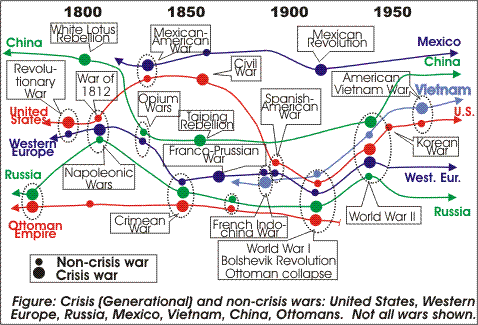You seem to be focusing in on the Crisis War, competition and evolution as your key assumptions. In many way, I think you are correct. You are going for the nub of it. Consider the following to be poke-around-the-edges stuff. The following points might not be used to disprove where you are going, but to complement the theory in predicting where Crisis Wars do not occur, and thus where cycles do not manifest.Originally Posted by John J. Xenakis
In nature, violent conflict among breeding groups is not the norm. When two packs contest for territory, the conflict is often resolved through ritual dominance displays rather than through fatal conflict. Among species where males compete for breeding opportunities, ritual non-lethal conflict is also common. Horns often evolve not to kill rivals, but to determine a winner in a non-lethal ritual conflict.
Evolution in nature is best served by non lethal competition among species. Evolution takes place at several levels. The best individual passes on genes, as does the best breeding group, as well as the best species. While lethal competition might produce the best individual the most quickly, such violence weakens the breeding group and the species. Thus, social instincts tend to evolve to moderate violence.
There are also factors of territory and population density. In general, conflict among animal groups are not clearly cyclical. A breeding group might have a given amount of territory. So long as the population of the breeding group is more or less stable, and there is no pressure reducing the territory from adjoining groups, conflicts are minimal. A time of plenty, of surplus, when more cubs survive, increases the chance of conflict. A famine, a disease, reduces population and thus the chance of conflict. For a cycle to develop, a steady state situation with a surplus seems required. In nature, you might want to do a little digging to determine how often such a situation would exist. My guess is that a regular pattern of lethal conflict between members of the same species would not be a large win for the species. It might be a survival trait to have fewer cubs, rather than have a pattern of extreme violence.
Switching to the special case human species...
You seem to have an implied assumption that if a culture has sufficient soldiers, a crisis war will be fought. This was not an unreasonable assumption prior to World War II and nuclear weapons. The assumption may yet prove to be true. Thing is, humans have evolving memes as well as evolving genes. If it becomes obvious that conflict between major powers does not benefit the major powers, a cycle theory based on an assumption that if soldiers then wars might break down.
Also, in the past, not all territories are worth fighting for. In many areas of the globe, there were not surpluses. Thus, it was hard to field a large warrior class. Thus, no population pressure. Thus, warlords who thought conquest was neat tended to get bred out of the population. Thus, no crisis war, no cycles. When studying history, it is easy to get drawn into the big countries and major wars. This might draw you into areas where there is generally a surplus, and thus warrior cultures are the norm. Still, the norm is not universal. Touching bases with cultures away from the cradles of civilization where surpluses were first developed might give you 'control' populations with no cycles. You might compare and contrast these with the surplus producing war zones.
You might dig into population dynamics. During a given era and area, how much of the population could be diverted to warfare? How did advances in agriculture increase surpluses, making warriors more cost effective, resulting in warrior cultures? Did antibiotics or other population increasing technologies effect or trigger cycles of violence? The desire to avoid major wars immediately after one was just fought is an admirable anchor to start a theory of warfare on, but World War I and II occurred closely enough together to suppose this is a universal law. You might look into agricultural, population, cultural and economic factors as well. Simplicity is nice in a theory, but not if the subject isn't simple.
On a more abstract level, yes, Strauss and Howe identified a good many patterns which are more or less true in the series of Anglo-American cycles. It does not follow that all of these patterns will be found in each and every cycle. I think you are correct that the crisis war is a key element that will be found in many crises, and that other elements S&H identified will not always be present.
But don't assume that because certain elements (such as crises wars) are common, there can't be cycles which don't feature these common elements. While most cycles might feature certain easily seen traits, and these easy to observe and understand cycles might be the best cycles to study first, leave room for other effects -- some cyclical, some not -- to be studied at some future time.
OK. I'm rambling. Go with it. I am into cycle theory, but don't think the factors that create cycles are necessarily always dominant. A deeper look at history would have to dig into other aspects.
Bob
- Join Date
- Jul 2001
- Location
- Cove Hold, Carver, MA
- Posts
- 6,431




